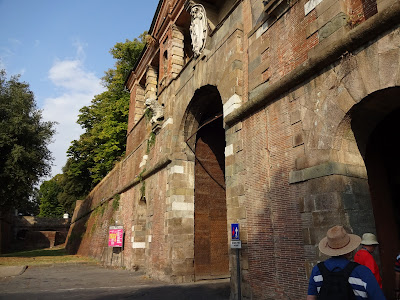St. Martin's Catheral at Lucca is a gargoyle's dream. From the gorgeous ceiling to the resting place for the Volto Santo (the Holy Face of Jesus), the Cathedral history goes back to Pope Alexander II, former Bishop of Lucca. The Pope built the Cathedral on the site of a former Church to accomodate the Holy Face of Jesus.
The Holy Face is now housed inside a very secure location shown here.
 |
| Holy Face at Lucca Cathedral |
From the Sacred Destinations.com site Lucca Cathedral ...
According to medieval legend, Nicodemus did all the carving work but the face, which he hesitated to complete for fear of not doing it justice. He fell asleep, and upon awaking found the face beautifully carved - the miraculous work of an angel. The Crucifix of the Holy Face was buried in a cave for safekeeping, where it remained for centuries.
It was rediscovered by Bishop Gualfredo, who was on a pilgrimage to the Holy Land when its location was revealed to him in a dream. To allow God to decide where the Crucifix should be kept, the bishop set it adrift on an unmanned boat in the Mediterranean Sea. The Volto Santo arrived on the shores of northern Italy, where the Bishop of Lucca, also prompted by a dream, put it into a wagon with no driver to determine its final location. The two oxen pulling the wagon stopped of their own accord at Lucca in 782.
The Volto Santo was placed in the Church of San Frediano, but the next morning, it was found to have been miraculously transferred to San Martino. For this reason, the legend explains, San Martino was designated the cathedral of Lucca (an honor previously held by Santi Giovanni e Reparata).
As usual, the real story is probably a little less exciting. There is no known mention of the Volto Santo before the 11th century, and for stylistic reasons it seems to be a 13th-century copy of a 11th-century original, perhaps necessitated by pilgrims chipping away at it. The original may have itself been based on an earlier model, perhaps a Syrian work of the 8th century.
The Volto Santo of Lucca was highly revered in the Middle Ages and attracted pilgrims from across Europe. Many copies were made and distributed, Lucca produced coins stamped with its image, the medieval French invented a St. Vaudeluc from a corruption of its Latin name (vultum de Lucca), and King William II of England (d.1100) was said to have sworn oaths per Vultum de Lucca ("by the Holy Face of Lucca").
There are many more great architectural features of this beautiful Cathedral, which I will discuss in another post.














































